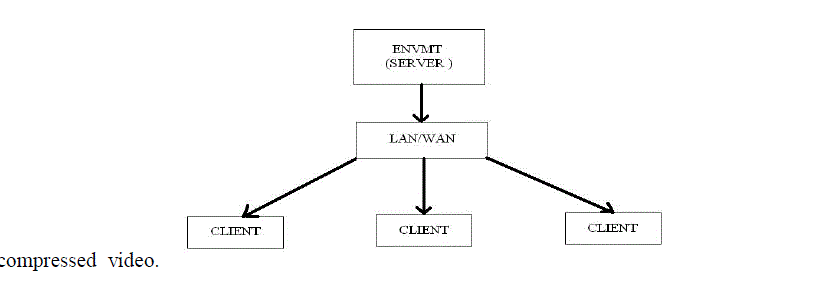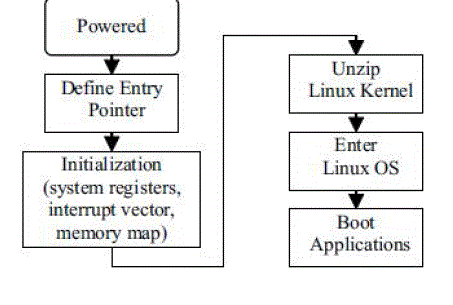The aim of our project is to develop embedded network video monitoring terminal which is cost effective and efficient video transmission system without latency and jitter. Digitalization network video monitoring system, which has advantages of unlimited distance control, flexible extension and so on, is becoming a new standard of security system. Due to limitations of network bandwidth, video signals collected must be compressed to achieve real-time video transmission on the network. to maintain the high quality of the compressed signal and to minimize the amount of data an embedded network video monitoring terminal consisting of dedicated MPEG-4 compression ,LPC 2148 MICRO CONTROLLER, 32-bit embedded ARM9 processor, network IC (DM 9000),PIR sensor, GSM modem etc. Its corresponding software has been developed. The video captured through the camera is processed and it is transmitted into the internet. The PIR sensor is used to detect the motion present in-front of the camera and it triggers the GSM modem to send the notification to the authorized users. Test results show that our terminal can better utilize TCP/IP network bandwidth.
Keywords |
| components: ENVMT, ARM9 processor, GSM modem, PIR sensor |
INTRODUCTION |
| Video monitoring system is an important part of the security system. In recent years, video monitoring
technology has made great progress together with the rapid development of the computer, network, image
processing and transmission technology. This paper proposes a video monitoring system based on embedded
network video monitoring terminal (ENVMT). The terminal can be used as network video server.
Conversions from analog signal, compression and network transmission of digital video are all through the
embedded terminal. It is small sized, low Cost, low power consuming, and its monitoring range is wide. The
video monitoring is carried out in Embedded Linux platform in ARM9 processor due to its flexibility. |
ARCHITECTURE OF THE VIDEO MONITORING SYSTEM BASED ON ENVMT |
| This section introduces the overall architecture of embedded network video monitoring
terminal. ENVMT captures video signal through the camera, transforms analog to digital signals, compress the
digital signals and releases to the network. Network video monitoring terminal provides functions such as alarm, and
the local video store. On the aspect of hardware, the entire system consists ofENVMT,anetwork central server and
clients. Each part connects within a network. On the aspect of software, ENVMT is responsible for capturing
audio and video signals, transforming signals from analog to digital, compressing digital signals, and
sending signals through the network. It also provides an alarm management function. The network
central server is mainly responsible for the video signal storage and query. It can respond to client requests and send data to users. The clients can use special software or Internet browser (Internet Explorer), so as to play compressed video. |
HARDWARE DESIGN OF ENVMT |
| ENVMT is a very important part of the network video monitoring system. It consists of an video acquisition
module, video data compression module, a control module, a network transmission module, a power module, an
alarm input and output module. This module consists of a 4 in 1 chipset and SDRAM. The chip integrates
video decoders and synthesizes four channel video signals to one. The integrated video decoder is a powerful
video signal preprocessing chip. It is used to implement analog-digital conversion, anti-aliasing filter, linear
phase locked, horizontal and vertical sync signal detection, and digital luminance separation. The Decoder is
able to decode analog video signal (i.e. NTSC, PAL or CVBS), to YUV4: 2:2 format digital video signals which
meet the CCIR601/CCIR656 standard The chip also provides rich functionality to support motion detection,
custom OSD (On Screen Display), image scaling, PIP (picture in picture) and camera lost detection. The
chip allows up to four chips cascade to process the 16 channel images. With this chip, ENVMT can easily
be extended. Analog video signals captured from the camera are decoded into digital signals inside the chip,
and then select the video 1 channel or 4 channels, or other combinations to output. The Output format meets
the CCIR656 standard. |
| A. Video Compression Module |
| The module, which consists of a dedicated MPEG-4 video chip and SDRAM, is the core module of ENVMT. It
provides a flexible compression and better compression quality. The dedicated MPEG-4 video compression
chip is a system-level chip. The image size can be programmed and its maximum size up to 2048 x 2048;
Supports fixed and variable bit rate compression, and support dynamic testing; Supports MEPG4/2/1 video
compression standard; Supports I,P and B frame compression. |
| B. Control module: |
| 32 bit ARM 7 LPC2148 it is mainly responsible for system initialization, interrupt control, hardware control,
the audio and video data package send through the network and reliable communication with the microcontroller. |
| C. Network transmission module: |
| DM9000 IC is a fully integrated and cost-effective single chip Fast Ethernet MAC controller with a
general processor interface, a 10/100M PHY and 4K Dword SRAM. |
| D. Alarm module |
| 32 bit Mini SC32440 provides number of general purpose input and output ports. So in ENVMT the
alarm input signal is switched through the optical coupling device isolation. Through GPIO input of the 32 bit Mini
SC32440 and processing , the GPIO outputs to the relay and generates alarm output switch signals. The module
can accept different types of alarm input and output, connect with different types of alarm input devices(i.e., IR
detection and voice detection), produce buzzer ,telephone and other alarm output. |
SOFTWARE DESIGN OF ENVMT |
| ENVMT Software includes two parts: |
| 1) 32-bit embedded CPU control program: it is mainly responsible for system initialization, interrupt control,
hardware control, the audio and video package sent through the network, and reliable communication with the
microcontroller. |
| 2) Control procedure based on 8-bit SCM : it is mainly used to control the AP5200 chip initialization, indicates
communication capabilities between the video signal and the embedded system, and receiver control
information from the main CPU. |
| A. Programming 32-bit embedded CPU Control |
| An entry pointer of the system software is automatically obtained from the second double words of chip select CS0
Corresponding memory. The memory is generally the FLASH memory. The entry pointer corresponding to BOOT
LOADER stores the system ‘s basic configuration and boots the system. After setting the system registers and
establishing of memory mapping, the system begins to initialize the basic external devices. Here UART0 is important because the system will shift print out here. After the end of the initialization, system boot information
can be seen by Hyper Terminal (UART0). |
| Linux Kernel is stored in the FLASH after compression. While running the FLASH is more slowly, so the
kernel needs to be decompressed to SDRAM during the BOOT LOADER program and then jumps to the entrance
of the system main function through jump command. Once the system initialization ends, rc script will automatically
run, Finally the applications run. |
| Applications are mainly responsible for the chip initialization of ENVMT and transmission of
compressed data. |
| B. Embedded Linux: |
| Embedded Linux typically refers to a complete system, or in the context of an embedded Linux vendor, to a
distribution targeted at embedded devices. Although the term “embedded” is often also used in kernel discussions
(especially between developers who have “embedded concerns”—words often used in the community), there is no
special form of the Linux kernel targeted at embedded applications. Instead, the same Linux kernel source code is
intended to be built for the widest range of devices, workstations, and servers imaginable, although obviously it is
possible to configure a variety of optional features according to the intended use of the kernel. |
| C. Boot loader: |
| A boot loader is responsible for loading an operating system kernel and its Supporting infrastructure
into memory, and beginning the kernel’s execution. |
| D. Kernel: |
| Kernel is a resource broker. It takes care of scheduling use of (and mediating access to) the available hardware
resources within a particular Linux system. Resources managed by the kernel include system processor time given to
programs, use of available RAM, and indirect access to a multitude of hardware devices including those customs to
your chosen target. The kernel provides a variety of software abstractions through which application programs can
request access to system resources, without communicating with the hardware directly. |
| E. Device Driver: |
| In embedded, a device driver or software driver is a program allowing higher-level computer programs to interact
with a hardware device. A device driver simplifies programming by acting as translator between a hardware device
and the applications or operating systems that use it. |
| F. Advantages of embedded Linux: |
| The advantages of embedded Linux over proprietary embedded operating systems include no royalties or
licensing fees, a stable kernel, a support base that is not restricted to the employees of a single software company,
and the ability to modify and redistribute the source code. |
RESULTS |
| a)Sender side: |
 |
 |
| b) Receiver side: (Administrators Login Page) |
 |
| c)Live Streaming and control |
 |
Figures at a glance |
 |
 |
| Figure 1 |
Figure 2 |
|
| |
References |
- Sutor,s, et al, âÃâ¬ÃÅLarge-Scale video surveillance system: New Performance Parameters and MetricâÃâ¬Ã ,ICIMPâÃâ¬Ãâ¢08:13, pp. 23 -30, June 2008.
- Nasution,A.H,et al, Intelligent Video Surveillance for Monitoring Elderly in Home Environment InternationalMMSPâÃâ¬Ãâ¢07, pp. 203 -206, Oct. 2007.
- âÃâ¬ÃÅDesign and Implementation of ENVMTâÃâ¬Ã by WangKechao ,RenXiangmin, WangZhifei, JiaZongfu, Yu JingweiSchoolofSoftware, HarbinUniversity,Harbin,China.
|